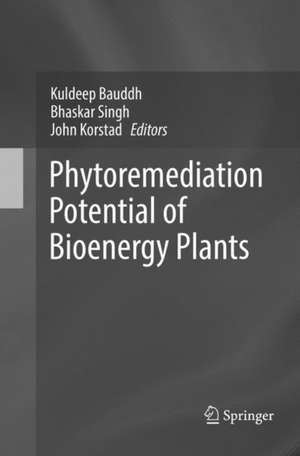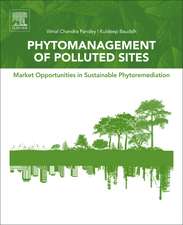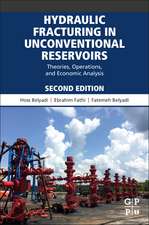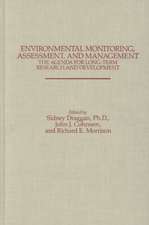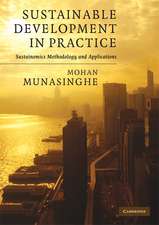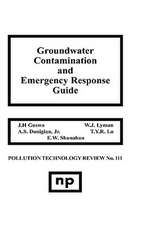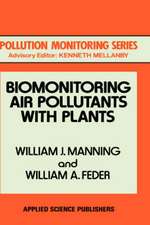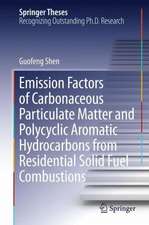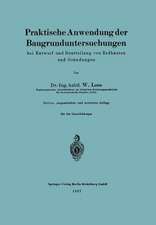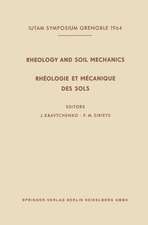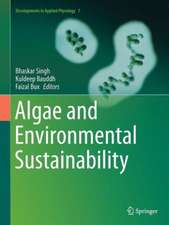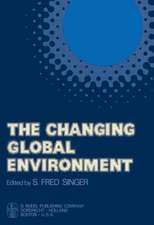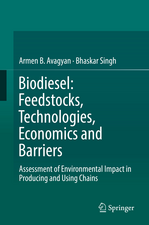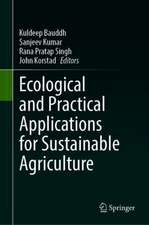Phytoremediation Potential of Bioenergy Plants
Editat de Kuldeep Bauddh, Bhaskar Singh, John Korstaden Limba Engleză Paperback – 7 aug 2018
Presently, there are technologies which have been proposed or shown to tackle both the problems. Researchers continue to seek more cost effective and environmentally beneficial pathways for problem solving.
Plant kingdom comprises of species which have the potential to resolve the couple problem of pollution and energy.
Plants are considered as a potential feedstock for development of renewable energy through biofuels. Another important aspect of plants is their capacity to sequester carbon dioxide and absorb, degrade, and stabilize environmental pollutants such as heavy metals, poly-aromatic hydrocarbons, poly-aromatic biphenyls, radioactive materials, and other chemicals.
Thus, plants may be used to provide renewable energy generation and pollution mitigation.
An approach that could amalgamate the two aspects can be achieved through phytoremediation (using plants to clean up polluted soil and water), and subsequent generation of energy from the phyto-remediator plants. This would be a major advance in achieving sustainability that focuses on optimizing ‘people’ (social issues), ‘planet’ (environmental issues), and ‘profit’ (financial issues).
The “Phytoremediation-Cellulosic Biofuels” (PCB) process will be socially beneficial through reducing pollution impacts on people, ecologically beneficial through pollution abatement, and economically viable through providing revenue that supplies an energy source that is renewable and also provides less dependence on importing foreign energy (energy-independence). The utilization of green plants for pollution remediation and energy production will also tackle some other important global concerns like global climate change, ocean acidification, and land degradation through carbon sequestration, reduced emissions of other greenhouse gases, restoration of degraded lands and waters, and more. This book addresses the overall potential of major plants that have the potential to fulfil the dual purposes of phytoremediation and energy generation. The non-edible bioenergy plants that are explored for this dual objective include Jatropha curcas, Ricinus communis, Leucaena leucocephalla, Milletia pinnata, Canabis sativa, Azadirachta indica, and Acacia nilotica.
The book addresses all possible aspects of phyto-remediaton and energy generation in a holistic way. The contributors are one of most authoritative experts in the field and have covered and compiled the best content most comprehensively. The book is going to be extremely useful for researchers in the area, research students, academicians and also for policy makers for an inclusive understanding and assessment of potential in plant kingdom to solve the dual problem of energy and pollution.
| Toate formatele și edițiile | Preț | Express |
|---|---|---|
| Paperback (1) | 597.43 lei 38-44 zile | |
| Springer Nature Singapore – 7 aug 2018 | 597.43 lei 38-44 zile | |
| Hardback (1) | 822.49 lei 38-44 zile | |
| Springer Nature Singapore – 7 apr 2017 | 822.49 lei 38-44 zile |
Preț: 597.43 lei
Preț vechi: 786.09 lei
-24% Nou
Puncte Express: 896
Preț estimativ în valută:
114.35€ • 124.26$ • 96.12£
114.35€ • 124.26$ • 96.12£
Carte tipărită la comandă
Livrare economică 18-24 aprilie
Preluare comenzi: 021 569.72.76
Specificații
ISBN-13: 9789811097850
ISBN-10: 9811097852
Pagini: 472
Ilustrații: XX, 472 p. 81 illus., 62 illus. in color.
Dimensiuni: 155 x 235 mm
Ediția:Softcover reprint of the original 1st ed. 2017
Editura: Springer Nature Singapore
Colecția Springer
Locul publicării:Singapore, Singapore
ISBN-10: 9811097852
Pagini: 472
Ilustrații: XX, 472 p. 81 illus., 62 illus. in color.
Dimensiuni: 155 x 235 mm
Ediția:Softcover reprint of the original 1st ed. 2017
Editura: Springer Nature Singapore
Colecția Springer
Locul publicării:Singapore, Singapore
Cuprins
Chapter 1. Phytoremediation: A multidimensional and ecologically viable practice for the cleanup of environmental contaminants (Poulomi Chakravarty).- Chapter 2. Bioenergy: A sustainable approach for cleaner environment (Abhishek Guldhe).- Chapter 3. Phytoremediation of Heavy Metal Contaminated Soil using Bioenergy Crops (Ambuj Bhushan Jha).- Chapter 4. PHYTOREMEDIATION OF SOIL CONTAMINANTS BY BIODIESEL PLANT Jatropha curcas (Abioye OP).- Chapter 5. Ricinus Communis: An ecological engineer and a biofuel resource (Dhananjay Kumar).- Chapter 6. Bioenergy and Phytoremediation Potential of Millettia pinnata (Dipesh kumar).- Chapter 7. PHYTOREMEDIATION POTENTIAL OF Leucaena leucocephala (Lam.) de Wit. FOR HEAVY METAL POLLUTED AND DEGRADED ENVIRONMENTS (Jamilu Edrisa Ssenku).- Chapter 8. Phytoremediation potential of industrially important and biofuel plants: Azadirachta indica and Acacia nilotica (Jaya Tiwari).- Chapter 9.Efficiency of an industrially important crop Hibiscus cannabinus for phytoremediation and bioenergy production (Neha Vishnoi).- Chapter 10. Canabis sativa: A plant suitable for Phytoremediation and Bioenergy production (Sanjeev Kumar).- Chapter 11. Phytoremediation and bioenergy production efficiency of medicinal and aromatic plants (Jisha C.K.).- Chapter 12. A sustainable approach to clean contaminated land using terrestrial grasses (Anju Patel).- Chapter 13. Macrophytes for the reclamation of degraded water bodies with potential for bio-energy production (Sangeeta Anand).- Chapter 14. Efficiency of bioenergy plant in phytoremediation of saline and sodic soil (Priyanka Bharti).- Chapter 15. Managing waste dumpsites through energy plantations (Vimal Chandra Pandey).- Chapter 16. Biotechnological intervention to enhance the potential ability of bioenergy plants for phytoremediation (Gulshan Singh).- Chapter 17. Sustainability of three (Jatropha, Karanja and Castor) oil seed bearing bio-energy plants for phytoremediation: A meta-analysis based case study of India (Dipesh Kumar).- Chapter 18. Phycoremediation: An ecofriendly algal technology for bioremediation and bioenergy production (Sanjay Kumar Gupta).- Chapter 19. Coupling phytoremediation appositeness with bioenergy plants: A socio-legal perspective (Rashwet Shrinkhal).
Notă biografică
Dr. Kuldeep Bauddh is currently an Assistant Professor of Environmental Science at the Centre for Environmental Sciences, Central University of Jharkhand, Ranchi, India. He received his Ph.D. in Environmental Science from the Babasaheb Bhimrao Ambedkar University, Lucknow, India in 2014. Dr. Bauddh is currently engaged in teaching the thrust areas of environmental sciences like Environmental Pollution and Management, Environmental Chemistry, Environmental Toxicology, Soil Science, and Hazardous Waste Management. He is also working as Associate Editor of the journal “Climate Change and Environmental Sustainability” and as Co-editor of the Magazine “Kahaar”. Dr. Bauddh is also Secretary of the Ranchi Chapter of the Society “Professor HS Srivastava Foundation for Science and Society”, Joint Secretary of the “Society for Science of Climate Change and Sustainable Environment”, and Joint Secretary of “Professor HS Srivastava Foundation for Science and Society”. His main research areas are phytoremediation, restoration of contaminated sites, and slow release fertilizers. He has published one book with Springer on “Algae and Environmental Sustainability”, as well as 28 research papers in national and international journals, 6 book chapters and 6 popular articles in magazines.
Dr. Bhaskar Singh received his Ph.D. from the Indian Institute of Technology (BHU), Varanasi, India in 2010 and his M.Phil. from Pondicherry (Central) University, India with a gold medal (2006). Dr. Bhaskar completed his postdoctoral fellowship at Durban University of Technology, Durban, South Africa. He is currently serving as an Assistant Professor at the Centre for Environmental Sciences, Central University of Jharkhand, Ranchi, India. Dr. Singh is currently engaged in teaching in the thrust areas of Environmental Sciences like Environmental Earth Science, Natural Resources, Environmental Chemistry, Environmental Pollution Monitoring & Control Technologies, Environmental Management & Sustainable Development, and Environmental Law & Legislation. He serves as a reviewer for several international journals such as Fuel, Energy, Renewable Energy, Renewable & Sustainable Energy Reviews, Energy & Fuels, Journal of Cleaner Production, Materials Chemistry and Physics, Biofuel Research Journal, Oceanologia, and Journal of Agricultural Biotechnology and Sustainable Development. Dr. Singh is also Treasurer of the Ranchi Chapter of the Society “Professor HS Srivastava Foundation for Science and Society”. His current interests lie in the application of biodiesel synthesis from plant oil and algal biomass, the development of heterogeneous and green catalysts, and the corrosive aspects of biodiesel fuel. Dr. Bhaskar has co-edited one book with Springer titled “Algae and Environmental Sustainability” along with Dr. Kuldeep Bauddh and Prof. Faizal Bux. His publications include 33 research and review papers in peer-reviewed and high-impact international journals, as well as 7 book chapters with reputed international publishers.
Professor John Korstad is a Professor of Biology and Past Director of the Honors Program at Oral Roberts Univ. in Tulsa, Oklahoma (USA). His educational background includes a BA in Geology and BS in Biology from Calif. Lutheran Univ., an MS in Environmental Science from Cal. State Hayward, and an MS and Ph.D. in Zoology from the Univ. of Michigan. His specialty is limnology (lake ecology), with specific expertise in nutrient-phytoplankton (microalgae)-zooplankton interactions. He has vast experience in aquaculture, including two sabbatical years conducting research at The Foundation for Scientific and Industrial Research (SINTEF) in Trondheim, Norway, which resulted in three published and numerous technical publications. He began pursuing algae to biofuels research during his Fall 2009 sabbatical leave. His goal is to bring together various industries like local oil refineries, electrical power plants, and cement factories that produce carbon dioxide waste, local industries like waste management landfills, and city sewage treatment plants with high nutrient loads in their waste water, in order to cultivate algae for biofuels. The algae would improve the air and water quality by taking up the waste CO2 and nutrients, while also providing a feedstock for biodiesel and/or ‘high-end’ products like omega-3 fatty acids. This would essentially be a win-win-win situation, and would hopefully develop into a vibrant industry that brings added jobs and revenue to the areas adopting it.
Dr. Bhaskar Singh received his Ph.D. from the Indian Institute of Technology (BHU), Varanasi, India in 2010 and his M.Phil. from Pondicherry (Central) University, India with a gold medal (2006). Dr. Bhaskar completed his postdoctoral fellowship at Durban University of Technology, Durban, South Africa. He is currently serving as an Assistant Professor at the Centre for Environmental Sciences, Central University of Jharkhand, Ranchi, India. Dr. Singh is currently engaged in teaching in the thrust areas of Environmental Sciences like Environmental Earth Science, Natural Resources, Environmental Chemistry, Environmental Pollution Monitoring & Control Technologies, Environmental Management & Sustainable Development, and Environmental Law & Legislation. He serves as a reviewer for several international journals such as Fuel, Energy, Renewable Energy, Renewable & Sustainable Energy Reviews, Energy & Fuels, Journal of Cleaner Production, Materials Chemistry and Physics, Biofuel Research Journal, Oceanologia, and Journal of Agricultural Biotechnology and Sustainable Development. Dr. Singh is also Treasurer of the Ranchi Chapter of the Society “Professor HS Srivastava Foundation for Science and Society”. His current interests lie in the application of biodiesel synthesis from plant oil and algal biomass, the development of heterogeneous and green catalysts, and the corrosive aspects of biodiesel fuel. Dr. Bhaskar has co-edited one book with Springer titled “Algae and Environmental Sustainability” along with Dr. Kuldeep Bauddh and Prof. Faizal Bux. His publications include 33 research and review papers in peer-reviewed and high-impact international journals, as well as 7 book chapters with reputed international publishers.
Professor John Korstad is a Professor of Biology and Past Director of the Honors Program at Oral Roberts Univ. in Tulsa, Oklahoma (USA). His educational background includes a BA in Geology and BS in Biology from Calif. Lutheran Univ., an MS in Environmental Science from Cal. State Hayward, and an MS and Ph.D. in Zoology from the Univ. of Michigan. His specialty is limnology (lake ecology), with specific expertise in nutrient-phytoplankton (microalgae)-zooplankton interactions. He has vast experience in aquaculture, including two sabbatical years conducting research at The Foundation for Scientific and Industrial Research (SINTEF) in Trondheim, Norway, which resulted in three published and numerous technical publications. He began pursuing algae to biofuels research during his Fall 2009 sabbatical leave. His goal is to bring together various industries like local oil refineries, electrical power plants, and cement factories that produce carbon dioxide waste, local industries like waste management landfills, and city sewage treatment plants with high nutrient loads in their waste water, in order to cultivate algae for biofuels. The algae would improve the air and water quality by taking up the waste CO2 and nutrients, while also providing a feedstock for biodiesel and/or ‘high-end’ products like omega-3 fatty acids. This would essentially be a win-win-win situation, and would hopefully develop into a vibrant industry that brings added jobs and revenue to the areas adopting it.
Textul de pe ultima copertă
The globally escalating population necessitates production of more goods and services to fulfil the expanding demands of human beings which resulted in urbanization and industrialization. Uncontrolled industrialization caused two major problems – energy crisis and accelerated environmental pollution throughout the world.
Presently, there are technologies which have been proposed or shown to tackle both the problems. Researchers continue to seek more cost effective and environmentally beneficial pathways for problem solving.
Plant kingdom comprises of species which have the potential to resolve the couple problem of pollution and energy.
Plants are considered as a potential feedstock for development of renewable energy through biofuels. Another important aspect of plants is their capacity to sequester carbon dioxide and absorb, degrade, and stabilize environmental pollutants such as heavy metals, poly-aromatic hydrocarbons, poly-aromatic biphenyls, radioactive materials, and other chemicals.
Thus, plants may be used to provide renewable energy generation and pollution mitigation.
An approach that could amalgamate the two aspects can be achieved through phytoremediation (using plants to clean up polluted soil and water), and subsequent generation of energy from the phyto-remediator plants. This would be a major advance in achieving sustainability that focuses on optimizing ‘people’ (social issues), ‘planet’ (environmental issues), and ‘profit’ (financial issues).
The “Phytoremediation-Cellulosic Biofuels” (PCB) process will be socially beneficial through reducing pollution impacts on people, ecologically beneficial through pollution abatement, and economically viable through providing revenue that supplies an energy source that is renewable and also provides less dependence on importing foreign energy (energy-independence). The utilization of green plants for pollution remediation and energy production will also tackle some other important global concerns like global climate change, ocean acidification, and land degradation through carbon sequestration, reduced emissions of other greenhouse gases, restoration of degraded lands and waters, and more.This book addresses the overall potential of major plants that have the potential to fulfil the dual purposes of phytoremediation and energy generation. The non-edible bioenergy plants that are explored for this dual objective includeJatropha curcas, Ricinus communis, Leucaena leucocephalla, Milletia pinnata, Canabis sativa, Azadirachta indica, andAcacia nilotica. The book addresses all possible aspects of phyto-remediaton and energy generation in a holistic way. The contributors are one of most authoritative experts in the field and have covered and compiled the best content most comprehensively. The book is going to be extremely useful for researchers in the area, research students, academicians and also for policy makers for an inclusive understanding and assessment of potential in plant kingdom to solve the dual problem of energy and pollution.
Presently, there are technologies which have been proposed or shown to tackle both the problems. Researchers continue to seek more cost effective and environmentally beneficial pathways for problem solving.
Plant kingdom comprises of species which have the potential to resolve the couple problem of pollution and energy.
Plants are considered as a potential feedstock for development of renewable energy through biofuels. Another important aspect of plants is their capacity to sequester carbon dioxide and absorb, degrade, and stabilize environmental pollutants such as heavy metals, poly-aromatic hydrocarbons, poly-aromatic biphenyls, radioactive materials, and other chemicals.
Thus, plants may be used to provide renewable energy generation and pollution mitigation.
An approach that could amalgamate the two aspects can be achieved through phytoremediation (using plants to clean up polluted soil and water), and subsequent generation of energy from the phyto-remediator plants. This would be a major advance in achieving sustainability that focuses on optimizing ‘people’ (social issues), ‘planet’ (environmental issues), and ‘profit’ (financial issues).
The “Phytoremediation-Cellulosic Biofuels” (PCB) process will be socially beneficial through reducing pollution impacts on people, ecologically beneficial through pollution abatement, and economically viable through providing revenue that supplies an energy source that is renewable and also provides less dependence on importing foreign energy (energy-independence). The utilization of green plants for pollution remediation and energy production will also tackle some other important global concerns like global climate change, ocean acidification, and land degradation through carbon sequestration, reduced emissions of other greenhouse gases, restoration of degraded lands and waters, and more.This book addresses the overall potential of major plants that have the potential to fulfil the dual purposes of phytoremediation and energy generation. The non-edible bioenergy plants that are explored for this dual objective includeJatropha curcas, Ricinus communis, Leucaena leucocephalla, Milletia pinnata, Canabis sativa, Azadirachta indica, andAcacia nilotica. The book addresses all possible aspects of phyto-remediaton and energy generation in a holistic way. The contributors are one of most authoritative experts in the field and have covered and compiled the best content most comprehensively. The book is going to be extremely useful for researchers in the area, research students, academicians and also for policy makers for an inclusive understanding and assessment of potential in plant kingdom to solve the dual problem of energy and pollution.
Caracteristici
A bio-refinery approach linking phytoremediation with energy generation Contains case studies on efficiency of phytoremediator plants in energy production Addresses an approach that addresses environmental sustainability along with economical viability
